On Developing Techniques for Sharing Satellite Spectrum with Indoor Small Cells in 5G †
Abstract
1. Introduction
1.1. Background
1.2. Related Work and Problem Statement
1.3. Contribution and Limitation
- We present two spectrum sharing techniques, namely orthogonal spectrum sharing (OSS) and non-orthogonal spectrum sharing (nOSS) techniques, for a hybrid iSMS and aTMS by extending our previous work in [22]. As an extension, first, the assumptions in [22] for the collocation of all CGC stations and SBSs per apartment in each building were relaxed, resulting in the deployment of small cell base stations (BSs) and CGC stations in a building following two independent and random processes so that small cell BSs (SBSs) and CGC stations can be deployed in four ways within an apartment, assuming that the occurrence of each deployment option is equally likely. Second, in addition to an OSS in [22], we present an nOSS technique that considers non-orthogonal sharing of the satellite spectrum with SBSs per 3D cluster of SBSs per building.
- We develop an interference management strategy to address co-channel interference as well as deduce an optimal number of almost blank subframes (ABSs) per ABS pattern period (APP) to ensure a fair allocation of time resources to SBSs and CGC stations, in apartments with collocated CGC stations and small cells.
- We then derive system-level capacity, spectral efficiency, and energy efficiency performance metrics and present an algorithm for OSS and nOSS techniques.
- Finally, we carry out extensive simulation and numerical analysis to evaluate the relative outperformance of one to another for nOSS and OSS techniques and show that both techniques can meet the expected spectral efficiency and energy efficiency requirements for 5G mobile networks.
- The performance evaluation was limited to only aTMS (i.e., the evaluation for the iSMS was considered beyond the scope of the paper).
- Since in general, user-plane traffic is considerably higher than that of control-plane traffic, for simplicity, we assumed that the impact of control-plane traffic due to the coordination among different components of the iSMS/aTMS for sharing the satellite spectrum of iSMS with in-building SBSs of aTMS was negligible. In other words, we limited the scope of this paper to evaluating only the user-plane traffic capacity of aTMS when sharing the spectrum of the iSMS with indoor SBSs. The evaluation of the required control-plane traffic capacity and hence the corresponding required bandwidth needs a detailed analysis of a number of factors, which was beyond the scope of the paper.
- Satellite spectrum sharing was considered only for the in-building SBSs. Hence, the co-channel interference was considered only within buildings.
- The satellite spectrum band of 3.5 GHz for the iSMS was considered for sharing with SBSs of the aTMS following [15], and keeping the satellite frequency close to that of the aTMS (i.e., 2 GHz) so that the transceivers’ frequency responses of SBSs did not deviate too high.
- The significance of the performance results of the proposed techniques was verified by comparing them with that expected for the 5G mobile networks in terms of spectral efficiency and energy efficiency.
- The performance results for the variation in the density of in-building SBSs (i.e., the number of buildings) per macrocell of the aTMS are shown, and the variation in other parameters was beyond the scope of the paper.
1.4. Organization
2. System Model
2.1. System Architecture
2.2. Modeling Placement of Complementary Ground Component (CGC) Stations and Small Cell Base Stations (SBSs)
- A subset of apartments deployed with neither a SBS nor a CGC station (i.e., );
- A subset of apartments deployed with only a SBS (i.e., );
- A subset of apartments deployed with only a CGC station (i.e., ); and
- A subset of apartments deployed with both a SBS and a CGC station (i.e., ).
2.3. Spectrum Sharing and Interference Management
3. Mathematical Analysis
3.1. Estimation for a Single Building
3.1.1. Macrocell User Equipment (UE) Capacity
3.1.2. When Both SBSs and CGC Stations Are Collocated
3.1.3. When Only a SBS is Deployed per Apartment
3.1.4. Overall System-Level Performances
3.2. Estimation for Multiple Buildings
4. Proposed Spectrum Sharing Algorithm and Optimal Number of ABSs
4.1. Proposed Spectrum Sharing Algorithm
4.2. Estimation of an Optimal Number of Almost Blank Subframes (ABSs)
| Algorithm 1 Proposed orthogonal and non-orthogonal spectrum sharing techniques |
| 01: Input: MSPS, MaTMS, TAPP, , , 02: For 03: For 04: Find using Equation (1) for all outdoor macro UEs 05: End 06: End 07: For 08: For 09: For 10: Find the following subsets of apartments for the building L: 11: 12: 13: 14: 15: Estimate for the building L 16: For % non-collocated 17: 18: End 19: For % collocated 20: If 21: 22: Elseif 23: 24: End 25: End 26: End 27: End 28: Find system-level capacity, spectral efficiency, and energy efficiency for the orthogonal allocation of the satellite spectrum with small cells for the building L using Equations (17)–(19) 29: Find system-level capacity, spectral efficiency, and energy efficiency for the non-orthogonal allocation of the satellite spectrum with small cells for the building L using Equations (20)–(22) 30: End 31: Estimate and Output: Plot system-level capacity, spectral efficiency, and energy efficiency for both orthogonal and non-orthogonal spectrum allocations to small cells for all . |
5. Parameters, Assumptions, and Preliminary Estimations
5.1. Default Parameters and Assumptions
5.2. Defining Cluster Size for nOSS
5.3. Estimating the Number of Apartments Containing SBSs and the Amount of Satellite Spectrum
6. Performance Result and Comparison
6.1. Performance Result
6.1.1. Capacity, Spectral Efficiency, and Energy Efficiency Performances
6.1.2. Impact of Co-Channel Interference on System Performances
6.2. Performance Comparison
7. Conclusions
Funding
Acknowledgments
Conflicts of Interest
Appendix A. Link Throughput
Appendix B. Modeling In-Building 3D Clusters of Nodes for nOSS
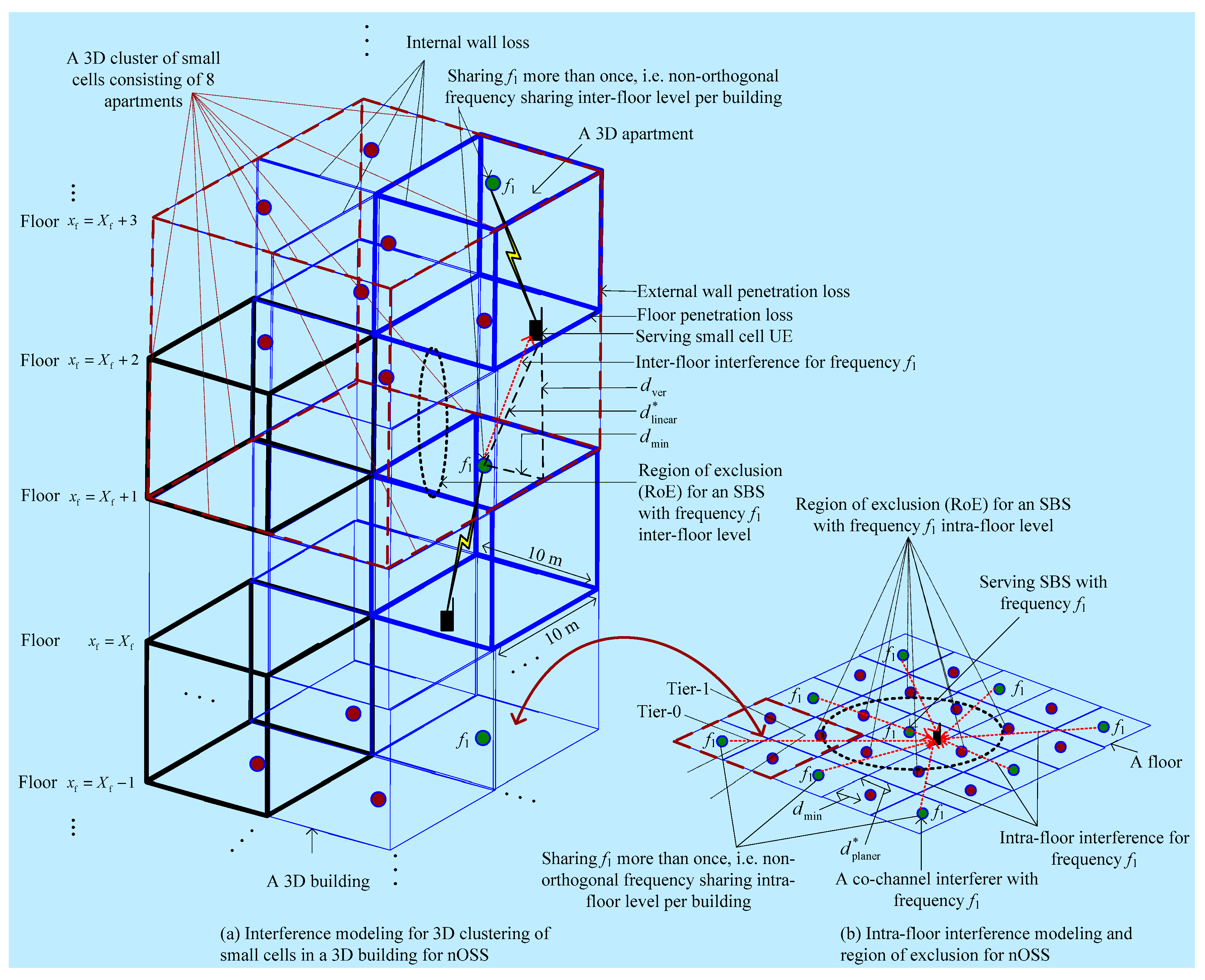
References
- Japan Assigns 5G Spectrum to Four Operators 5G Observatory. Available online: https://5gobservatory.eu/japan-assigns-5g-spectrum-to-four-operators/ (accessed on 27 January 2020).
- MIC the Radio Use Website. Available online: https://www.tele.soumu.go.jp/resource/e/search/myuse/use0303/10000m.pdf (accessed on 27 January 2020).
- Gohar, M. From 4G to 5G. In Opportunities in 5G Networks: A Research and Development Perspective, 1st ed.; Hu, F., Ed.; CRC Press: Boca Raton, FL, USA, 2016; pp. 33–34. [Google Scholar]
- Report: 80% of All Mobile Data is Consumed by Just 10% of Users. Available online: https://gigaom.com/2015/02/04/report-80-of-all-mobile-data-is-consumed-by-just-10-of-users/ (accessed on 27 January 2020).
- Saha, R.K. Nationwide Spectrum Sharing of Mobile Network Operators with Indoor Small Cells. In Proceedings of the 2019 IEEE International Symposium on Dynamic Spectrum Access Networks (DySPAN), Newark, NJ, USA, 11–14 November 2019; pp. 1–2. [Google Scholar]
- Deslandes, V.; Tronc, J.; Beylot, A.-L. Analysis of Interference Issues in Integrated Satellite and Terrestrial Mobile Systems. In Proceedings of the 5th Advanced Satellite Multimedia Systems Conference, Cagliari, Italy, 13–15 September 2010; pp. 256–261. [Google Scholar]
- Park, U.; Kim, H.W.; Oh, D.S.; Chang, D.L. Performance Analysis of Dynamic Resource Allocation for Interference Mitigation in Integrated Satellite and Terrestrial Systems. In Proceedings of the 9th International Conference on Next Generation Mobile Applications, Services and Technologies, Cambridge, UK, 9–11 September 2015; pp. 217–221. [Google Scholar]
- Scenarios and Performance of an Integrated MSS System Operating in Frequency Bands Below 3 GHz; CH-1211 Genève 20 Suisse, Report ITU-R M.2398-0; International Telecommunication Union—Radio communication sector (ITU-R): Geneva, Switzerland, 2016.
- Hybrid Satellite-Terrestrial System. Available online: http://tec.gov.in/pdf/Studypaper/Hybrid%20Satellite_Terrestrial%20Systems_Study Paper_Final.pdf (accessed on 2 October 2018).
- Feng, W.; Ge, N.; Lu, J. Coordinated Satellite-Terrestrial Networks: A Robust Spectrum Sharing Perspective. In Proceedings of the 26th Wireless Optical Communication Conference (WOCC), Newark, NJ, USA, 7–8 April 2017; pp. 1–5. [Google Scholar]
- Monte, P.A. Resource Allocation to Terrestrial and Satellite Services. U.S. Patent 8 594 682 B2, 21 Febuary 2012. [Google Scholar]
- Mayfield, A. Commercial System Employing Reuse of Satellite Spectrum for Terrestrial Communication. U.S. Patent 6 735 437 B2, 11 May 2004. [Google Scholar]
- Satellite Earth Stations and Systems (SES). Advanced Satellite Based Scenarios and Architectures for Beyond 3G Systems; TR 102 662, ver. 1.1.1; European Telecommunications Standards Institute (ETSI): Sophia Antipolis Valbonne, France, 2010. [Google Scholar]
- Use and Examples of Mobile-Satellite Service Systems for Relief Operation in The Event of Natural Disasters and Similar Emergencies; CH-1211 Genève 20 Suisse, Report ITU-R M.2149-1; International Telecommunication Union—Radio communication sector (ITU-R): Geneva, Switzerland, 2011.
- In Proceedings of the Federal Communications Commission (FCC), 445 12th Street, SW, Washington, DC, USA, 12 December 2012. Available online: https://www.fcc.gov/document/fcc-proposes-innovative-small-cell-use-35-ghz-band (accessed on 29 October 2018).
- Study on New (NR) to Support Non Terrestrial Networks (Release 15); document 3GPP TR 38.811; 3rd Generation partnership Project (3GPP): Sophia Antipolis Valbonne, France, 2018.
- Khawar, A.; Ahmad, I.; Sulyman, A.I. Spectrum Sharing Between Small Cells and Satellites: Opportunities and Challenges. In Proceedings of the IEEE ICCW, London, UK, 8–12 June 2015; pp. 1600–1605. [Google Scholar]
- Saha, R.K. Spectrum Sharing in Satellite-Mobile Multisystem Using 3D In-Building Small Cells for High Spectral and Energy Efficiencies in 5G and Beyond Era. IEEE Access 2019, 7, 43846–43868. [Google Scholar] [CrossRef]
- Saha, R.K. A Tactic for Architectural Exploitation of Indoor Small Cells for Dynamic Spectrum Sharing in 5G. IEEE Access 2020, 8, 15056–15071. [Google Scholar] [CrossRef]
- Sun, Q.; Nan, S. Coexistence Studies Between LTE-Hotspot Indoor and Earth Station of Fixed Satellite Service in the Band 3400–3600MHz. In Proceedings of the 2012 IEEE 11th International Conference on Signal Processing, Beijing, China, 21–25 October 2012; pp. 2275–2278. [Google Scholar]
- Höyhtyä, M. Sharing FSS Satellite C Band with Secondary Small Cells and D2D Communications. In Proceedings of the 2015 IEEE International Conference on Communication Workshop (ICCW), London, UK, 8–12 June 2015; pp. 1606–1611. [Google Scholar]
- Saha, R.K. A Technique for Licensed Spectrum Sharing Between Space-Satellite and Terrestrial-Mobile Heterogeneous Multisystem. In Proceedings of the 2019 Joint Conference on Satellite Communications (JC SAT 2019), JR Hakata City, Fukuoka, Japan, 10–11 October 2019; pp. 103–108. [Google Scholar]
- Chandrasekhar, V.; Andrews, J.G.; Gatherer, A. Femtocell Networks: A Survey. IEEE Commun. Mag. Sep. 2008, 46, 59–67. [Google Scholar] [CrossRef]
- Wong, M. Femtocells-Secure Communication and Networking; River Publishers: Aalborg, Denmark, 2013; pp. 77–78. [Google Scholar]
- Saha, R.K.; Aswakul, A. A Tractable Analytical Model for Interference Characterization and Minimum Distance Enforcement to Reuse Resources in Three-Dimensional In-Building Dense Small Cell Networks. Int. J. Commun. Syst. 2017, 30, e3240. [Google Scholar] [CrossRef]
- Sharma, S.K.; Chatzinotas, S.; Ottersten, B. Satellite Cognitive Communications: Interference Modeling and Techniques Selection. In Proceedings of the ASMS/SPSC, Baiona, Spain, 5–7 September 2012; pp. 111–118. [Google Scholar]
- Guidotti, A.; Vanelli-Coralli, A.; Conti, M.; Andrenacci, S.; Chatzinotas, S.; Maturo, N.; Awoseyila, A.; Ugolini, A.; Foggi, T.; Gaudio, L.; et al. Architectures and Key Technical Challenges for 5G Systems Incorporating Satellites. IEEE Trans. Veh. Technol. 2019, 68, 2624–2639. [Google Scholar] [CrossRef]
- Chimeh, J.D.; Hakkak, M.; Alavian, S.A. Internet Traffic and Capacity Evaluation in UMTS Downlink. In Proceedings of the Future Generation Communication and Networking (FGCN), Jeju-Island, Korea, 6–8 December 2007; pp. 547–552. [Google Scholar]
- European Telecommunications Standards Institute (ETSI); Universal mobile telecommunications system (UMTS). Selection Procedures for the Choice of Radio Transmission Technologies of the UMTS; TR 101 112, UMTS 30.03, ver. 3.2.0.; European Telecommunications Standards Institute (ETSI): Sophia Antipolis Valbonne, France, 1998–2004. [Google Scholar]
- E-UTRA. Radio Frequency (RF) System Scenarios; Document 3GPP TR 36.942, V.1.2.0; 3rd Generation Partnership Project (3GPP): Sophia Antipolis Valbonne, France, 2007. [Google Scholar]
- Simulation Assumptions and Parameters for FDD HeNB RF Requirements; Document TSG RAN WG4 (Radio) Meeting #51, R4-092042; 3rd Generation Partnership Project (3GPP): Sophia Antipolis Valbonne, France, 2009.
- Wang, C.-X.; Haider, F.; Gao, X.; Xiaohu, Y.; Yang, Y.; Yuan, D.; Aggoune, H.M.; Haas, H.; Fletcher, S.; Hepsaydir, E. Cellular Architecture and Key Technologies for 5G Wireless Communication Networks. IEEE Commun. Mag. 2014, 52, 122–130. [Google Scholar] [CrossRef]
- Yuan, G.; Zhang, X.; Wang, W.; Yang, Y. Carrier Aggregation for LTE-Advanced Mobile Communication Systems. IEEE Commun. Mag. 2010, 48, 88–93. [Google Scholar] [CrossRef]
- Auer, G.; Giannini, V.; Desset, C.; Gódor, I.; Skillermark, P.; Olsson, M.; Imran, M.A.; Sabella, D.; Gonzalez, M.J.; Blume, O. How Much Energy is Needed to Run a Wireless Network? Green Radio Communication Networks; Cambridge University Press: Cambridge, UK, 2012; p. 20. [Google Scholar]
- Saha, R.K. Realization of Licensed/Unlicensed Spectrum Sharing Using eICIC in Indoor Small Cells for High Spectral and Energy Efficiencies of 5G Networks. Energies 2019, 12, 2828. [Google Scholar] [CrossRef]
- Saha, R.K.; Aswakul, A. A Novel Frequency Reuse Technique for In-Building Small Cells in Dense Heterogeneous Networks. IEEJ Trans. Electr. Electron. Eng. 2018, 13, 98–111. [Google Scholar] [CrossRef]
- Saha, R.K.; Aswakul, A. Incentive and Architecture of Multi-Band Enabled Small Cell and UE for Up-/Down-Link and Control-/User-Plane Splitting for 5G Mobile Networks. Freq. J. RF Eng. Telecomm. 2017, 71, 95–118. [Google Scholar] [CrossRef]
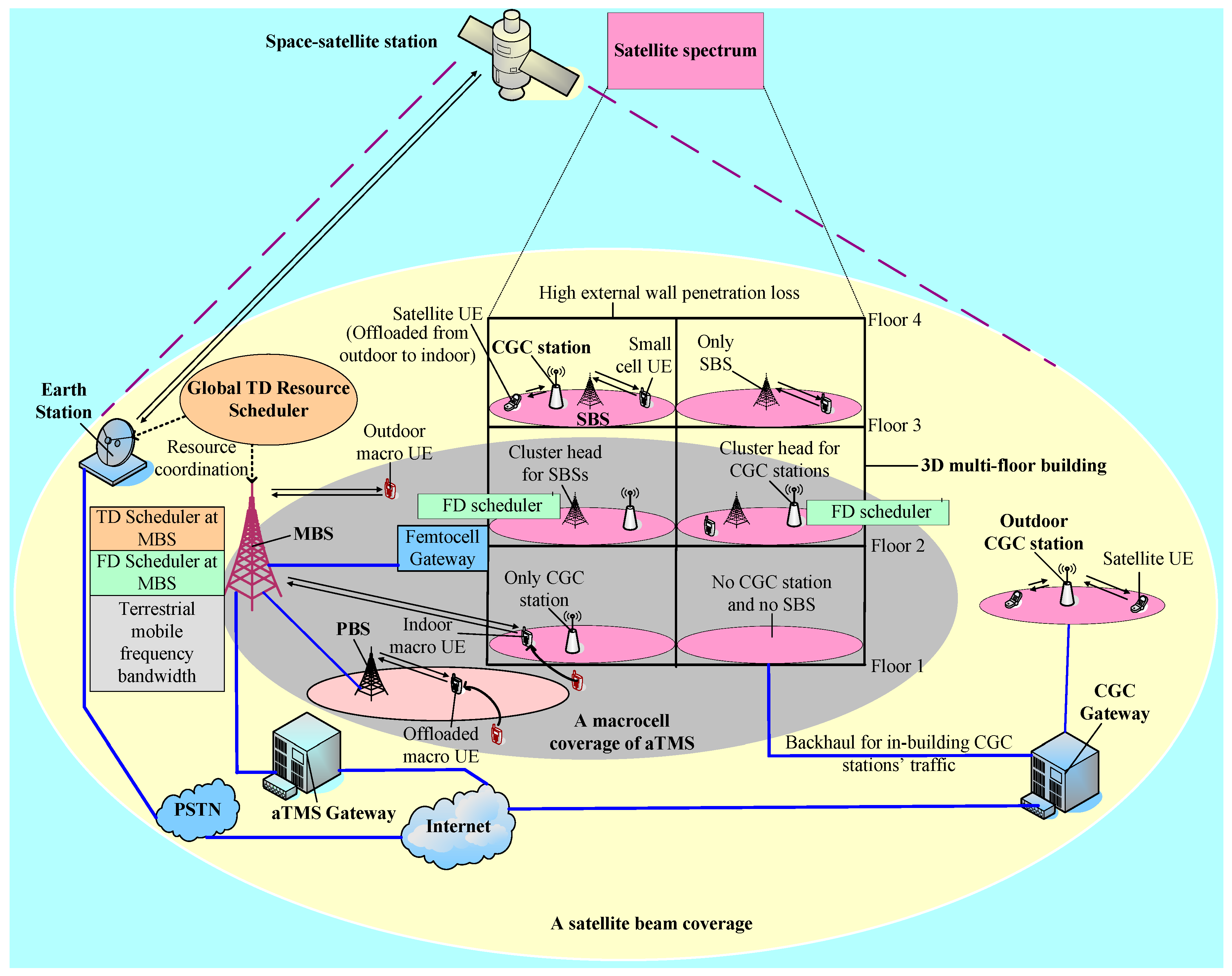
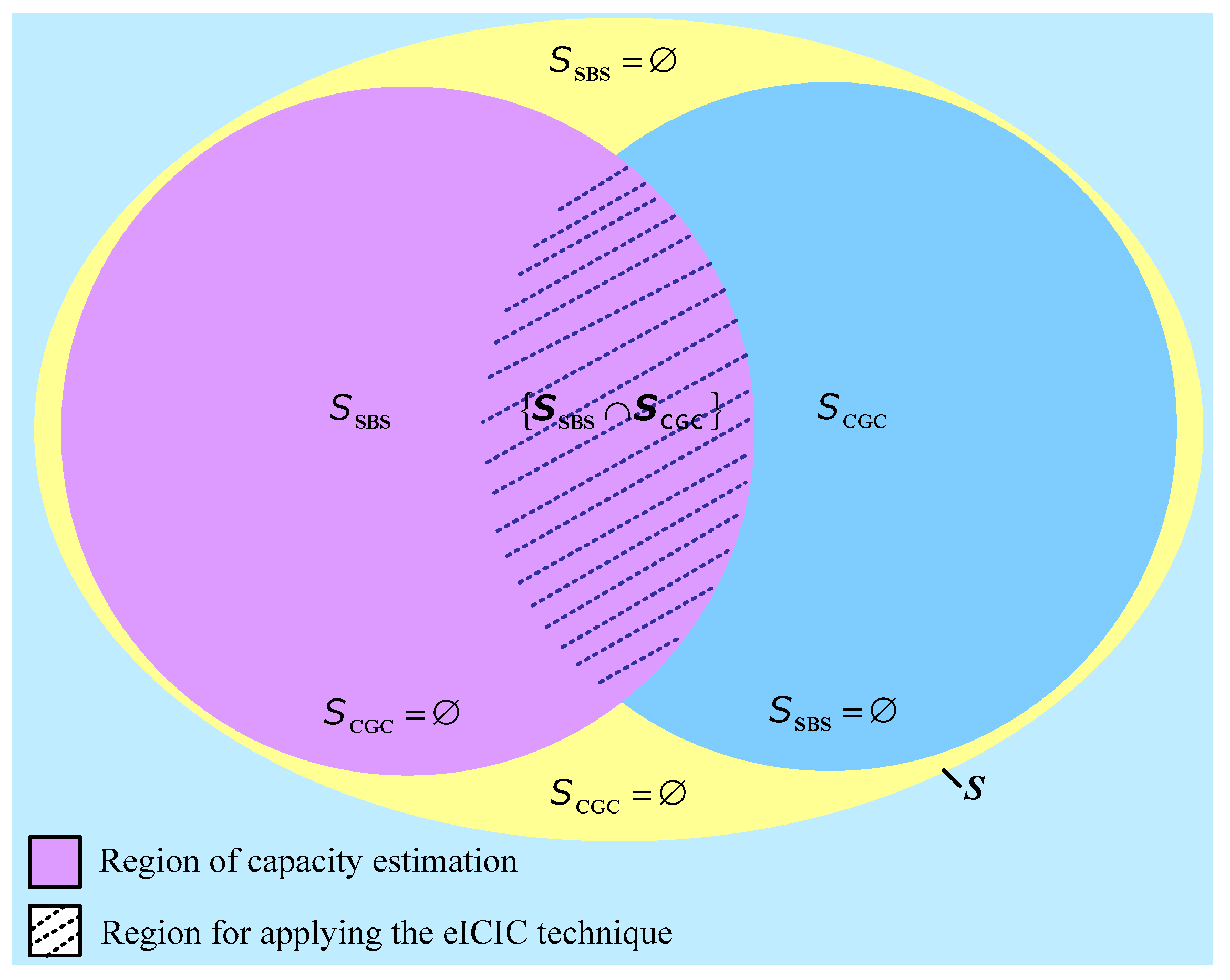
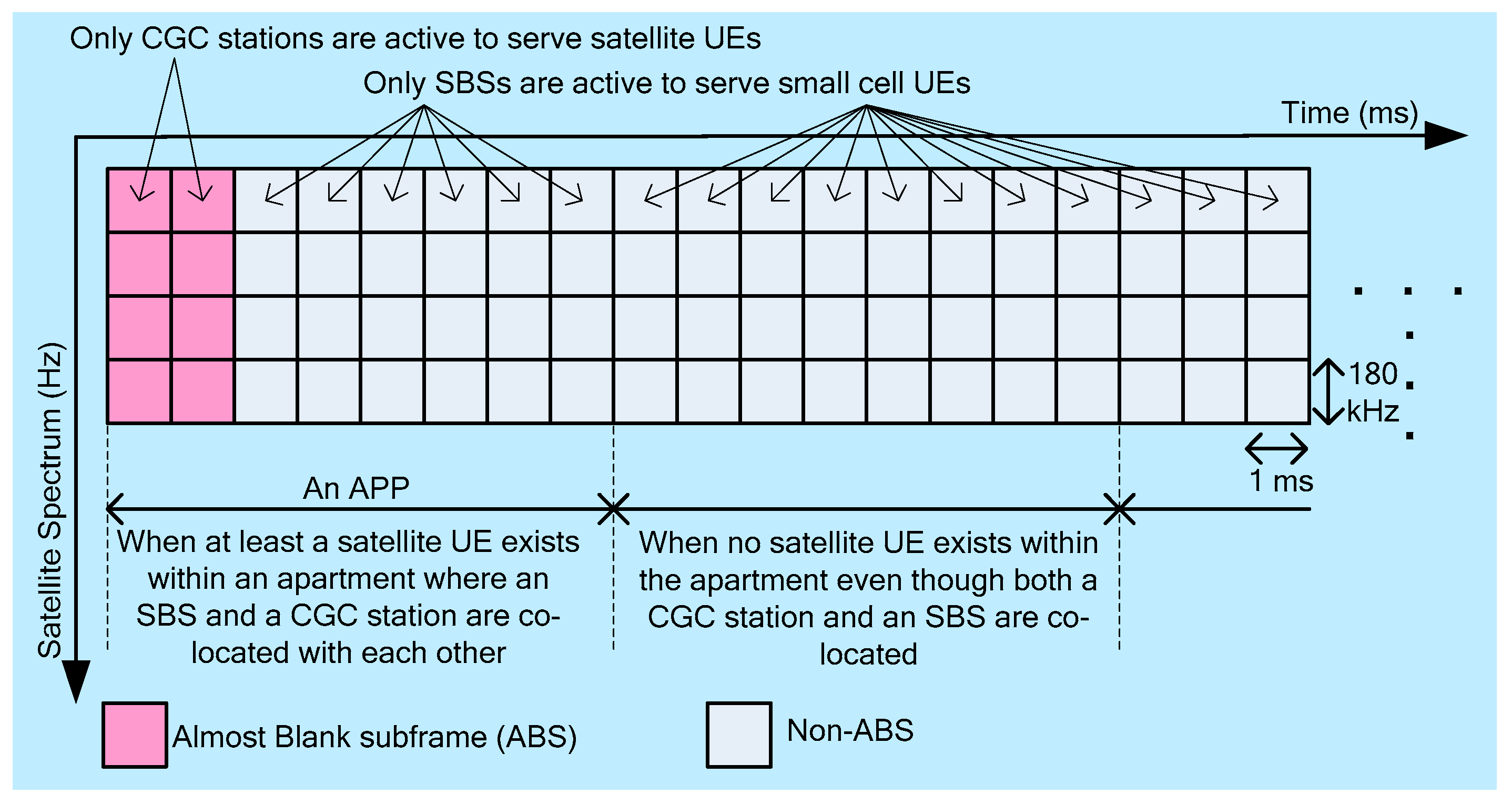
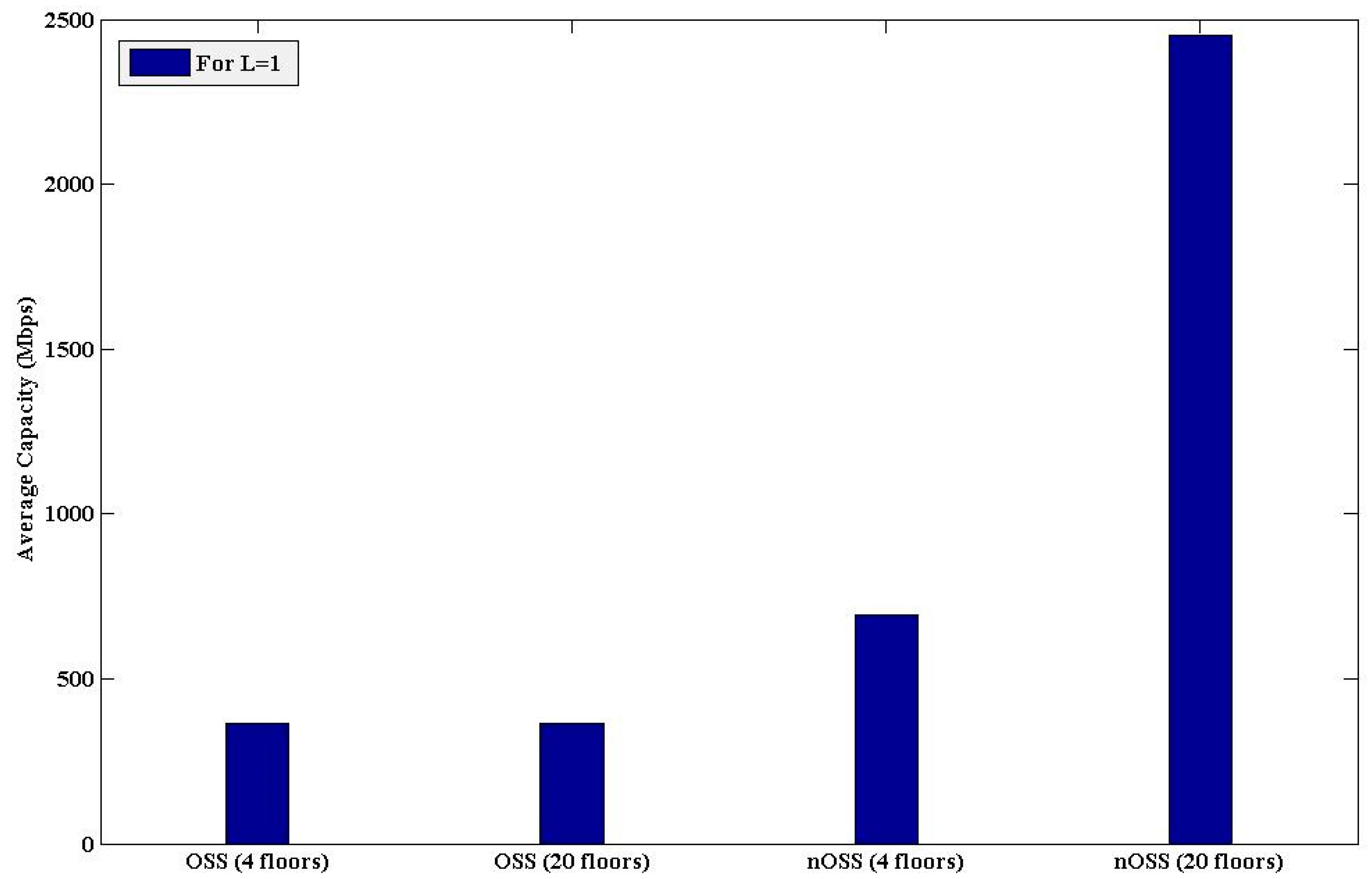
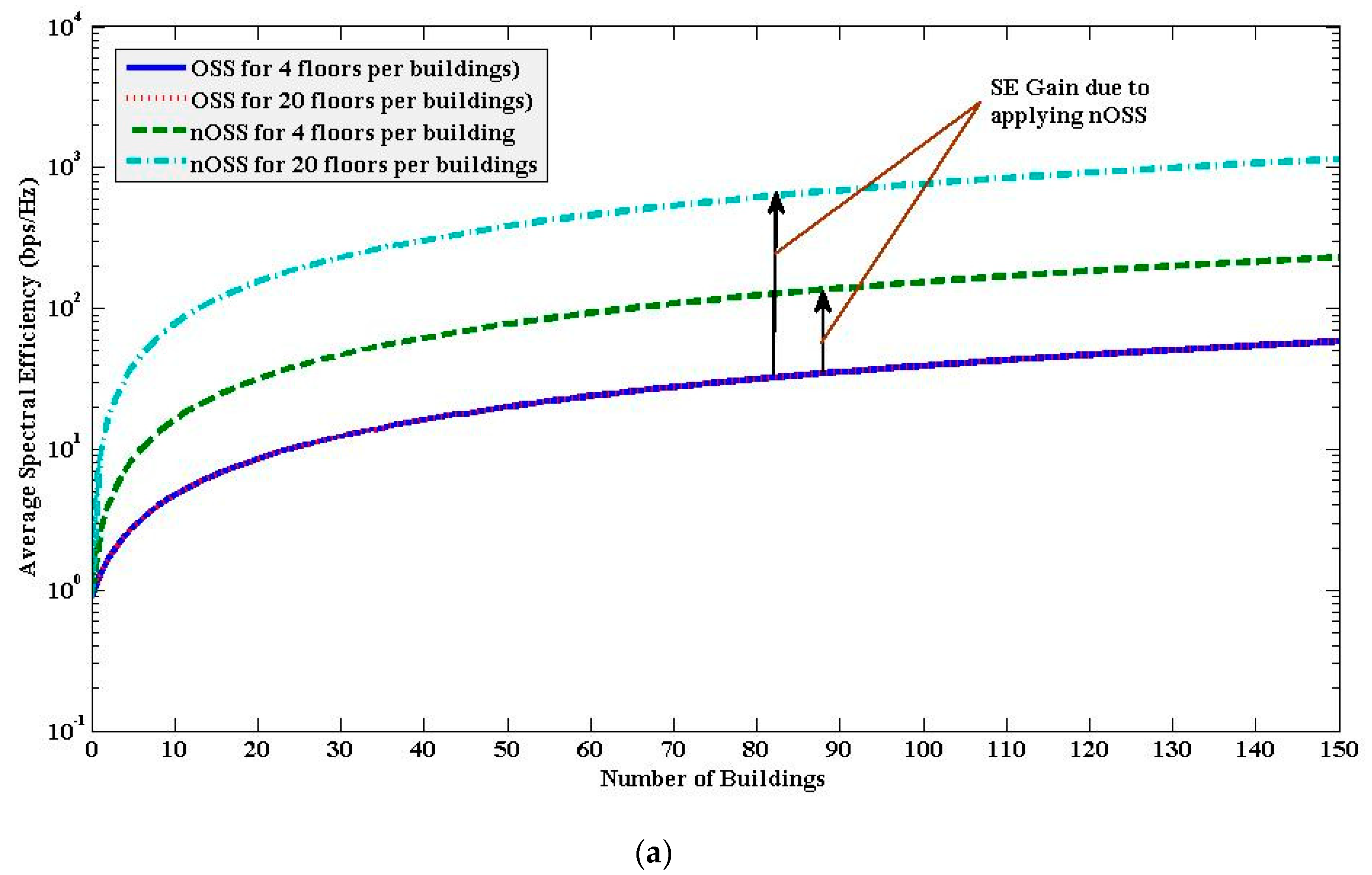

| Parameters and Assumptions | Value | |||
|---|---|---|---|---|
| E-UTRA simulation case 1 | 3GPP case 3 | |||
| Satellite type and operating frequency band | GEO or LEO, S-band | |||
| Effect of the mobility of satellite spot-beam cells on the satellite UE handover between the satellite and a CGC station | None | |||
| Cellular layout 2 and Inter-site distance (ISD) 1,2 | Hexagonal grid, dense urban, 3 sectors per macrocell site and 1732 m | |||
| Carrier frequency 2 and transmit direction | 2 GHz (mobile system), 3.5 GHz (satellite system), and downlink | |||
| System bandwidth | 40 MHz (for both mobile and satellite systems) | |||
| Operating spectrum band (satellite) | CGC stations, in-building SBSs | |||
| Operating spectrum band (aTMS) | Macrocell BS, picocell BSs | |||
| Considered system for performance evaluation | TMSs only | |||
| Number of cells per building | 1 macrocell, 2 picocells, 16 CGC stations (maximum), and 16 SBSs (maximum) | |||
| External wall penetration loss 1 (Low) | 20 dB | |||
| Total BS transmit power 1 (dBm) | 46 for microcell 1, 37 for picocell 1, 20 for CGC station or SBS1 | |||
| Co-channel fading model 1 | Frequency selective Rayleigh for macrocell and picocell and Rician for SBS and CGC station | |||
| Path loss | Macrocell BS and a UE 1 | Indoor macro UE | PL(dB) = 15.3 + 37.6log10R, R is in m | |
| Outdoor macro UE | PL(dB) = 15.3 + 37.6log10R + Low, R is in m | |||
| Picocell BS and a UE1 | PL(dB) = 140.7 + 36.7log10R, R is in km | |||
| SBS/CGC and a UE 1,2 | PL(dB) = 127 + 30log10(R/1000), R is in m | |||
| Lognormal shadowing standard deviation (dB) | 8 for Macrocell BS 2, 10 for Picocell BS 1, 10 for CGC station and 10 for SBS 2 | |||
| Antenna configuration | Single-input single-output for all terrestrial mobile BSs and UEs | |||
| Antenna pattern (horizontal) | Directional (1200) for macrocell 1 and omnidirectional for picocell 1, CGC stations and SBS1 | |||
| Antenna gain plus connector loss (dBi); UE antenna gain 2 | 14 for Macrocell BS 2, 5 for Picocell BS 1, 5 for CGC station and SBS 1; 0 dBi | |||
| UE noise Figure 2 and UE speed 1 | 9 dB, 3 km/h | |||
| Total number of macro UEs; Maximum number of satellite UEs served simultaneously by a CGC station | 30; 1 | |||
| Maximum number of small cell UEs served simultaneously by a SBS | 1 | |||
| Picocell coverage and macro UEs offloaded to all picocells 1; Indoor macro UEs 1 | 40 m (radius), 2/15; 35% | |||
| 3D multi-story building (regular square-grid) | Number of buildings | L | ||
| Floors per building | 4 | |||
| Apartments per floor | 8 | |||
| Number of the apartment per building | 32 | |||
| Apartment area | (10 × 10) m2 | |||
| Number of apartments with | Collocated CGC stations and SBSs | 8 | ||
| Only SBSs | 8 | |||
| Only CGC stations | 8 | |||
| Neither CGC stations nor SBSs | 8 | |||
| Scheduler and traffic model 2 | Proportional Fair and full buffer | |||
| Type of SBSs | Closed subscriber group | |||
| Channel state information | Ideal | |||
| and | 2/8, 8/8 | |||
| TTI 1 and scheduler time constant (tc), and TAPP | 1 ms, 100 ms, and 8 ms | |||
| Parameters and assumptions for nOSS technique | ; , , , , | |||
| Scenario | (m) | (m) | (m) | ||||||||
|---|---|---|---|---|---|---|---|---|---|---|---|
| 1 | 0.578 | 0.044 | 12 | 7.07 | 5 | 2 | 4 | 2 | 8 | 32 | 4 |
| 2 | 0.05 | 0.03 | 27.14 | 7.81 | 6 | 4 | 16 | 2 | 32 | 160 | 5 |
| 3 | 0.05 | 0.044 | 27.14 | 7.07 | 5 | 4 | 16 | 2 | 32 | 160 | 5 |
| 4 | 0.578 | 0.03 | 12 | 7.81 | 6 | 2 | 4 | 2 | 8 | 160 | 20 |
| 5 | 0.578 | 0.1 | 12 | 4.24 | 3 | 2 | 4 | 1 | 4 | 160 | 40 |
© 2020 by the author. Licensee MDPI, Basel, Switzerland. This article is an open access article distributed under the terms and conditions of the Creative Commons Attribution (CC BY) license (http://creativecommons.org/licenses/by/4.0/).
Share and Cite
Saha, R.K. On Developing Techniques for Sharing Satellite Spectrum with Indoor Small Cells in 5G. Energies 2020, 13, 748. https://doi.org/10.3390/en13030748
Saha RK. On Developing Techniques for Sharing Satellite Spectrum with Indoor Small Cells in 5G. Energies. 2020; 13(3):748. https://doi.org/10.3390/en13030748
Chicago/Turabian StyleSaha, Rony Kumer. 2020. "On Developing Techniques for Sharing Satellite Spectrum with Indoor Small Cells in 5G" Energies 13, no. 3: 748. https://doi.org/10.3390/en13030748
APA StyleSaha, R. K. (2020). On Developing Techniques for Sharing Satellite Spectrum with Indoor Small Cells in 5G. Energies, 13(3), 748. https://doi.org/10.3390/en13030748





